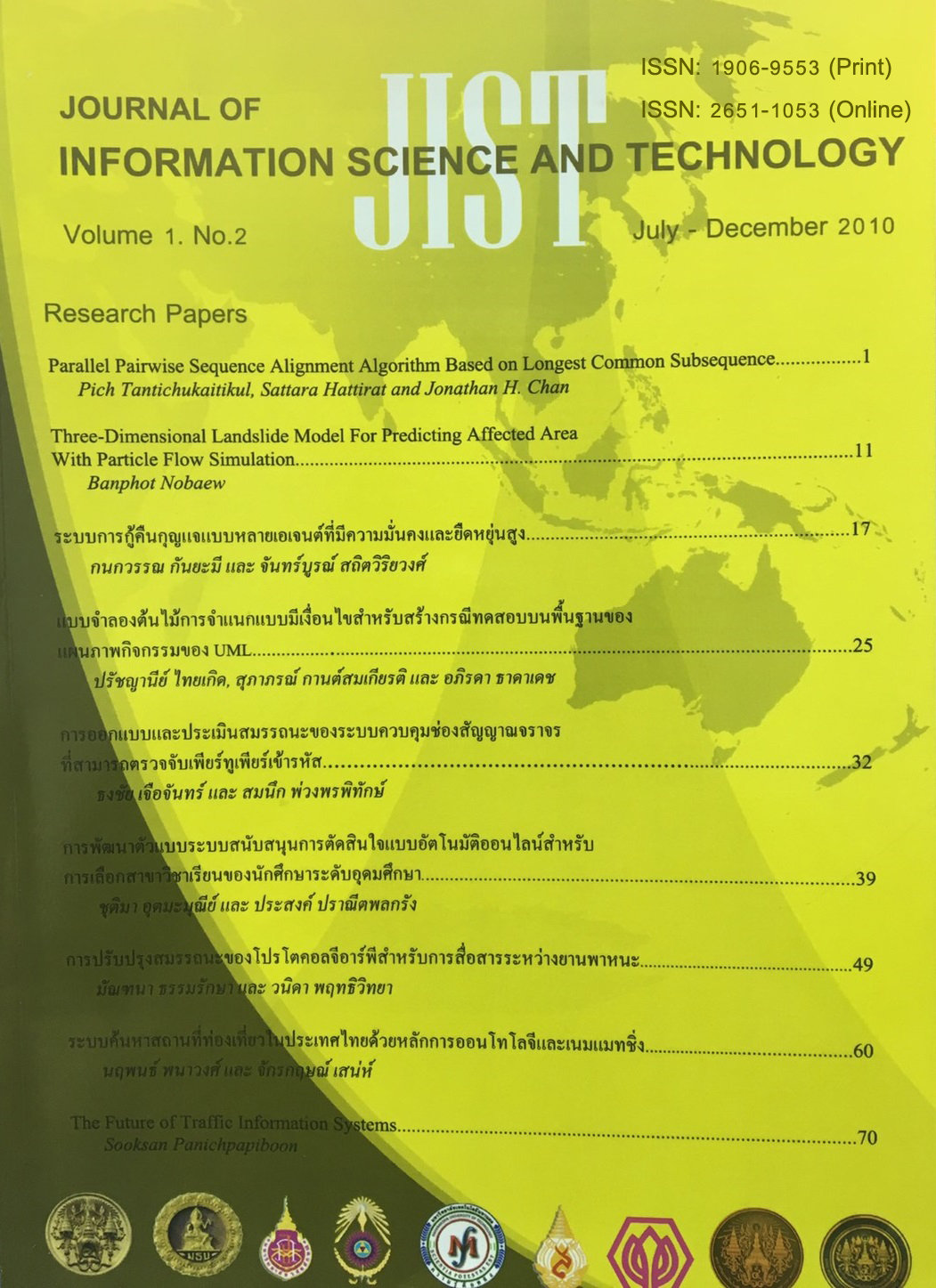แบบจำลองต้นไม้การจำแนกแบบมีเงื่อนไขสำหรับสร้างกรณีทดสอบบนพื้นฐานของแผนภาพกิจกรรมของ UML
Main Article Content
บทคัดย่อ
- ประสิทธิภาพของการทดสอบซอฟต์แวร์ขึ้นอยู่กับคุณภาพความครอบคลุมของข้อมูลนำเข้าที่ใช้ในการทดสอบในปัจจุบันซอฟต์แวร์ส่วนใหญ่ถูกพัฒนาขึ้นโดยใช้เทคโนโลยีเชิงวัตถุ และมีภาษามากมายที่ถูกพัฒนาขึ้นเพื่อสนับสนุนการออกแบบซอฟต์แวร์เชิงวัตถุ ภาษาที่ได้รับความนิยมเป็นอย่างมากคือ ภาษาการออกแบบเชิงโมเดล (Unified Modeling Language: UML) งานวิจัยนี้พิจารณาแผนภาพกิจกรรม (Activity Diagram) ซึ่งเป็นแผนภาพประเภทหนึ่งของ UML แผนภาพนี้ถูกใช้เพื่อโมเดลพฤติกรรมของซอฟต์แวร์ ดังนั้นการนำโมเดลจากขั้นตอนนี้มาใช้ในการสร้างกรณีทดสอบจะทำ ให้สามารถสร้างกรณีทดสอบได้ในขั้นตอนการออกแบบซอฟต์แวร์ บทความนี้เสนอแบบจำลองต้นไม้การจำแนกแบบมีเงื่อนไขสำหรับสร้างกรณีทดสอบจากแผนภาพกิจกรรม แบบจำลองนี้ช่วยให้กรณีทดสอบที่สร้างขึ้นมีประสิทธิภาพและช่วยลดเวลาในการวิเคราะห์เอกสารความต้องการ ผลลัพธ์ที่ได้จากการทดลองแสดงให้เห็นว่าหลักการที่ได้นำเสนอสามารถช่วยให้กรณีทดสอบที่สร้างมีจำนวนน้อย มีความเหมาะสมและสามารถกระทำได้ตั้งแต่ช่วงต้นของกระบวนการพัฒนาซอฟต์แวร์
Article Details
This work is licensed under a Creative Commons Attribution-NonCommercial-NoDerivatives 4.0 International License.
I/we certify that I/we have participated sufficiently in the intellectual content, conception and design of this work or the analysis and interpretation of the data (when applicable), as well as the writing of the manuscript, to take public responsibility for it and have agreed to have my/our name listed as a contributor. I/we believe the manuscript represents valid work. Neither this manuscript nor one with substantially similar content under my/our authorship has been published or is being considered for publication elsewhere, except as described in the covering letter. I/we certify that all the data collected during the study is presented in this manuscript and no data from the study has been or will be published separately. I/we attest that, if requested by the editors, I/we will provide the data/information or will cooperate fully in obtaining and providing the data/information on which the manuscript is based, for examination by the editors or their assignees. Financial interests, direct or indirect, that exist or may be perceived to exist for individual contributors in connection with the content of this paper have been disclosed in the cover letter. Sources of outside support of the project are named in the cover letter.
I/We hereby transfer(s), assign(s), or otherwise convey(s) all copyright ownership, including any and all rights incidental thereto, exclusively to the Journal, in the event that such work is published by the Journal. The Journal shall own the work, including 1) copyright; 2) the right to grant permission to republish the article in whole or in part, with or without fee; 3) the right to produce preprints or reprints and translate into languages other than English for sale or free distribution; and 4) the right to republish the work in a collection of articles in any other mechanical or electronic format.
We give the rights to the corresponding author to make necessary changes as per the request of the journal, do the rest of the correspondence on our behalf and he/she will act as the guarantor for the manuscript on our behalf.
All persons who have made substantial contributions to the work reported in the manuscript, but who are not contributors, are named in the Acknowledgment and have given me/us their written permission to be named. If I/we do not include an Acknowledgment that means I/we have not received substantial contributions from non-contributors and no contributor has been omitted.
เอกสารอ้างอิง
2. Object Management Group, “Unified modeling language. Specification v1.5 formal/2003-03-01”, Object Management Group, March 2003.
3. T. Y. Chen , Pak-Lok Poon , Sau-Fun Tang, and T. H. Tse, “Identification of Categories and Choices in Activity Diagrams”, the 5th International Conference on Quality Software (QSIC 2005), IEEE Computer Society, September 2005, pp. 55-63.
4. W. Sinzhang, Y. Jiesong, Y. Xiaofeng, H. Jun, L. Xuandong, and Z. Guoliang, “Generating Test Cases from UML Activity Diagram based on Gray-Box Method”, the 11th Asia-Pacific Software Engineering Conference(APSEC), IEEE Computer Society, November 2004, pp. 284-291.
5. T. Y. Chen and P. L. Poon, “Teaching black box testing”, the 1998 International Conference on Software engineering: Education and Practice, IEEE Computer Society Press, January 1998. pp. 324-329.
6. M. Grochtmann, K. Grimm, and J. Wegener, “Tool - Supported Test Case Design for Black-Box Testing by Means of the Classification - Tree Editor”, the 1st European International Conference on Software Testing Analysis and Review, London UK, October 1993. pp. 25-28.
7. M. Grochtmann, J. Wegener, K. Grimm, “Test case design using classification trees and the classification-tree editor CTE”, the 8th International Software Quality Week, 1995. pp. 1-11.
8. A. J. Offutt, A. Lee, G. Rothermel, R. Untch, and C. Zapf, “An experimental determination of sufficient mutation operators”, ACM Transaction on Software Engineering Methodology, Vol 5, No. 2, pp. 99-118, April 1996.



